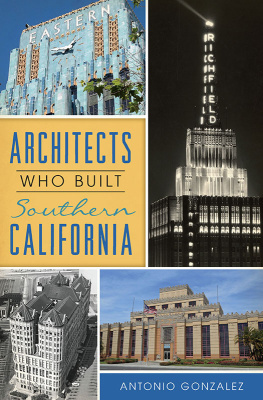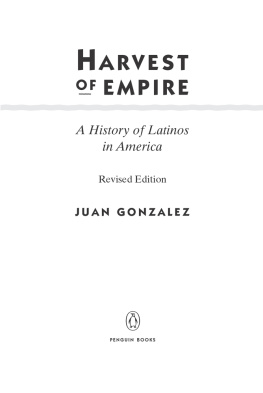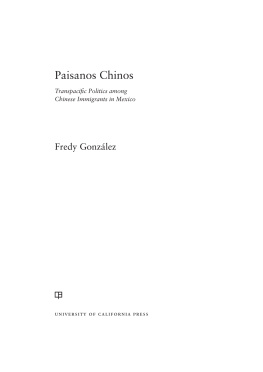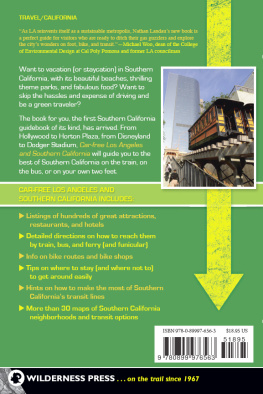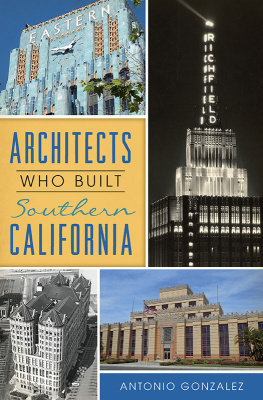Gonzalez - Architects Who Built Southern California
Here you can read online Gonzalez - Architects Who Built Southern California full text of the book (entire story) in english for free. Download pdf and epub, get meaning, cover and reviews about this ebook. City: Southern California, year: 2019, publisher: The History Press, genre: Non-fiction. Description of the work, (preface) as well as reviews are available. Best literature library LitArk.com created for fans of good reading and offers a wide selection of genres:
Romance novel
Science fiction
Adventure
Detective
Science
History
Home and family
Prose
Art
Politics
Computer
Non-fiction
Religion
Business
Children
Humor
Choose a favorite category and find really read worthwhile books. Enjoy immersion in the world of imagination, feel the emotions of the characters or learn something new for yourself, make an fascinating discovery.
- Book:Architects Who Built Southern California
- Author:
- Publisher:The History Press
- Genre:
- Year:2019
- City:Southern California
- Rating:4 / 5
- Favourites:Add to favourites
- Your mark:
- 80
- 1
- 2
- 3
- 4
- 5
Architects Who Built Southern California: summary, description and annotation
We offer to read an annotation, description, summary or preface (depends on what the author of the book "Architects Who Built Southern California" wrote himself). If you haven't found the necessary information about the book — write in the comments, we will try to find it.
Gonzalez: author's other books
Who wrote Architects Who Built Southern California? Find out the surname, the name of the author of the book and a list of all author's works by series.
Architects Who Built Southern California — read online for free the complete book (whole text) full work
Below is the text of the book, divided by pages. System saving the place of the last page read, allows you to conveniently read the book "Architects Who Built Southern California" online for free, without having to search again every time where you left off. Put a bookmark, and you can go to the page where you finished reading at any time.
Font size:
Interval:
Bookmark:

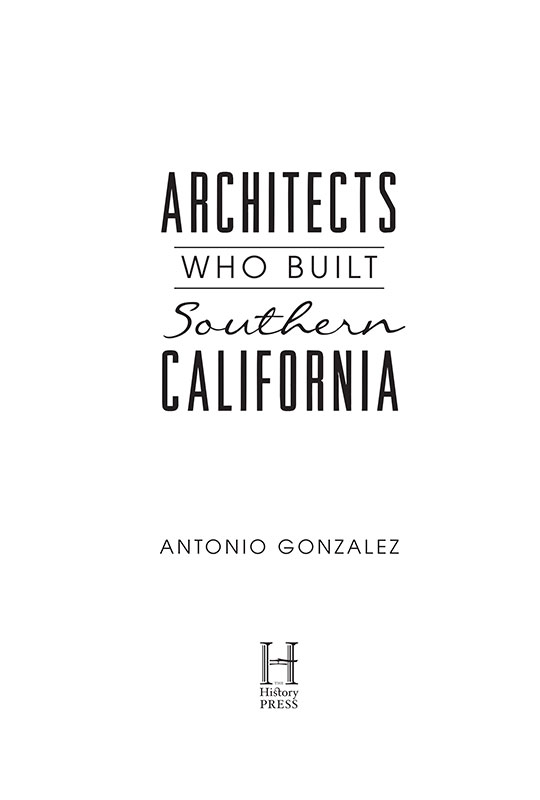
Published by The History Press
Charleston, SC
www.historypress.com
Copyright 2019 by Antonio Gonzalez
All rights reserved
First published 2019
e-book edition 2019
ISBN 978.1.43966.634.0
Library of Congress Control Number: 2018963524
print edition ISBN 978.1.46714.183.3
Notice: The information in this book is true and complete to the best of our knowledge. It is offered without guarantee on the part of the author or The History Press. The author and The History Press disclaim all liability in connection with the use of this book.
All rights reserved. No part of this book may be reproduced or transmitted in any form whatsoever without prior written permission from the publisher except in the case of brief quotations embodied in critical articles and reviews.
CONTENTS
PREFACE
I was unable to locate photographs of O.W. Morgan, W.A.O. Munsell and Philip W. Holler. I did find one of Mendel Meyer but chose not to use it. If anyone related to them has photographs I could use in a future edition of this book, please contact me via my website. If anyone holds the personal papers of any of these architects, I would like to read through them and take notes.
I was interested in writing about architects who hadnt been the subject of much research, so selection was chiefly based on that criteria. Julia Morgan was the exception, but that was because I felt I could add to her scholarship regarding the construction of certain buildings.
I admire all of these architects. Many of them made mistakes during their lives, but what they accomplished far exceeds any of their mistakes. I chose to include the unsavory along with the noteworthy because every time I stumbled upon a new revelation, I read the news accounts wondering why the information wasnt common knowledge to the countless individuals who are fixated, like me, on Southern California architects and their architecture.
I hope Architects Who Built Southern California prompts more research into their lives and more books about them.
ACKNOWLEDGEMENTS
I was assisted in this endeavor by a wide variety of people who were extremely helpful. They include Matthew Allnatt, the Jonathan Club; Vinayak Bharne, USC; Pamela Clark, YMCA; Tess Conyers, AC Martin Partners; Kathleen Correia, California State Library; Myles Crowley, MIT; Kendel Darragh, the Library of Michigan; Robert Graef, my lifelong friend; Lambert Giessinger, Los Angeles Department of City Planning; Mike Jones, BPO Elks; Laurie Krill and Abigail Fleming, my wonderful editors at The History Press; Anuja Navare, Pasadena Museum of History; Linda Reed, Stanford Alumni Association; Marccus Reinhardt, California Architects Board; Christina Rice, Los Angeles Public Library; Renato Rodriguez, San Diego History Center; Trudi Sandmeier, USC Heritage Conservation Program; Rio L. Santonil, Al Malaikah Shrine Center; Marcello Vavala, Los Angeles Conservancy; Ruth Wallach, the University of Southern California; Stacy Williams, the University of Southern California; Robert Witney, the Mary Baker Eddy Library; Erin Chase and Steve Hindle, the Huntington Library; Alan Sieroty and Grace Doyle, Sieroty Co.; Tim Strawn and Laura Sorvetti, Cal Poly, San Luis Obispo; Yolanda Bustos, Richard P. Hulser, Brent Riggs and John Cahoon, the Natural History Museum of Los Angeles County; and special thanks to my friend Mark Snowden, who always pointed out when I was acting like a know-it-all, listened to me ramble on about these architects endlessly and gave me feedback regarding this book.
INTRODUCTION
In 1910, an article appeared in the Los Angeles Times titled, Are Buildings to Go Higher? Octavius Morgan was the author, and in the piece he addressed the questions of building height and the recent exceptions that had been allowed by city hall. Within the previous few months, the architect of the Alexandria Hotels annex had requested a variance for the building that included adding thirty feet in height to create a mansard roof. It was allowed. Then, architect A.L. Haley requested and received a variance for the Higgins building, which was under construction at Second and Main Streets. Constructed of reinforced concrete, the Higgins buildings height went from 120 feet to 133 feet.
In April 1910, the approved city height for steel-framed buildings was 150 feet and 120 feet for concrete-reinforced buildings.
In the Times article, Morgan came out against buildings going higher. He said there was no reason for a congested business district in Los Angeles because there was ample land for expansion east, west and south of the central business district. Morgan also stated there was no river that constrained expansion in any direction, something with which other cities, such as New York, must contend. He asserted that most skyscrapers are built as advertisements for their owners, and most owners have concluded that ten to twelve stories is a profitable height. Morgan continued, noting that even in New York City most large buildings are eight, ten or twelve stories, with some notable exceptions, citing the Metropolitan Life block, which is only eight stories but has a forty-story tower, and the Singer Building, which was twelve stories with a forty-seven-story tower.
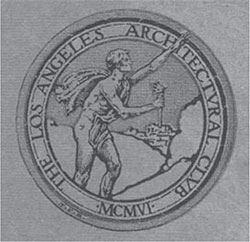
The Los Angeles Architectural Club was responsible for yearly architectural exhibits that contained drawings, models and other architectural paraphernalia. Most of the prominent architects in Southern California participated in the exhibitions. From the Year Book: Los Angeles Architectural Club, 1913.
Morgan went on to say that cities like Chicago and New York needed skyscrapers because of the physical conditions of their sites, their enormous populations and their centralized business districts. He could count on one hand the number of beautiful skyscrapers in the United States and listed two that portend to beauty, citing the Call Building in San Francisco and the Trinity Building in New York as having that quality.
Finally, Morgan said the height of a concrete building is entirely an engineering issue, but he believed eight stories was a safe and profitable limit. The following week, many local architects responded to Morgans opinion piece in another Times column, The Skyscraper: Morgan Starts a Discussion.
Architect A.L. Haley, who designed the ten-story Higgins building, said more office space would be necessary when the citys population surpassed one million. He stated that office space would have to increase threefold and claimed that the city ordinance limiting the height of reinforced-concrete buildings was discriminatory.
Another architect, Harrison Albright, said the New York skyline resembled a ragged comb with teeth knocked out. He proposed that all of the skyscrapers in Los Angeles be of the same height, making Los Angeles skyline the most beautiful in the country. He also stated reinforced-concrete buildings could resist severe earthquake shocks more readily.
Alfred Rosenheim, who was president of the Los Angeles Architectural Club, said, I am opposed to building steel buildings over 150 feet in height and do not approve of either the raising of the steel frame limit by means of the mansard roof to 180 feet or of the recent change permitting reinforced concrete buildings to go to 133 feet.
John Austin, who was one of the men responsible for establishing the limits in the first place, was quoted as saying he stood pat on the limits.
Next pageFont size:
Interval:
Bookmark:
Similar books «Architects Who Built Southern California»
Look at similar books to Architects Who Built Southern California. We have selected literature similar in name and meaning in the hope of providing readers with more options to find new, interesting, not yet read works.
Discussion, reviews of the book Architects Who Built Southern California and just readers' own opinions. Leave your comments, write what you think about the work, its meaning or the main characters. Specify what exactly you liked and what you didn't like, and why you think so.

